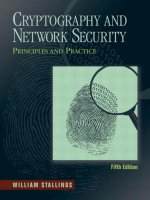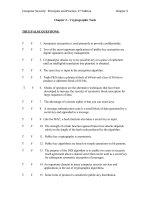Computer security principles and practice 3rd by williams stallings and brown ch01
Bạn đang xem bản rút gọn của tài liệu. Xem và tải ngay bản đầy đủ của tài liệu tại đây (4.37 MB, 25 trang )
© 2016 Pearson
Education, Inc.,
Hoboken, NJ. All rights
reserved.
Chapter 1
Overview
© 2016 Pearson Education, Inc.,
Hoboken, NJ. All rights reserved.
The NIST Computer Security
Handbook defines the term
Computer Security as:
“The protection afforded to an
automated information system in order to
attain the applicable objectives of
preserving the integrity, availability and
confidentiality of information system
resources” (includes hardware, software,
firmware, information/data, and
telecommunications).
© 2016 Pearson Education, Inc.,
Hoboken, NJ. All rights reserved.
grity
I nte
Confiden
tiality
The CIA Triad
Data
and
services
A v a il
y
t
i
l
i
b
a
© 2016
Pearson
Education,
Inc., Hoboken,
NJ. All rights
Key Security Concepts
Confidentiality
Integrity
• Guarding
• Preserving
against
authorized
improper
restrictions on
information
information
modification or
access and
destruction,
disclosure,
including
including
ensuring
means for
information
protecting
nonrepudiation
personal
and
privacy and
authenticity
proprietary
information
© 2016 Pearson Education, Inc.,
Hoboken, NJ. All rights reserved.
Availability
• Ensuring timely
and reliable
access to and
use of
information
Levels of Impact
Low
Moderat
e
High
The loss could
be expected to
have a limited
adverse effect
on
organizational
operations,
organizational
assets, or
individuals
The loss could
be expected to
have a serious
adverse effect
on
organizational
operations,
organizational
assets, or
individuals
The loss could
be expected to
have a severe
or catastrophic
adverse effect
on
organizational
operations,
organizational
assets, or
individuals
© 2016 Pearson Education, Inc.,
Hoboken, NJ. All rights reserved.
Computer Security
Challenges
• Computer security is not as
•
•
•
•
simple as it might first
appear to the novice
Potential attacks on the
security features must be
considered
Procedures used to provide
particular services are
often counterintuitive
Physical and logical
placement needs to be
determined
Additional algorithms or
protocols may be involved
© 2016 Pearson Education, Inc.,
Hoboken, NJ. All rights reserved.
• Attackers only need to find a
•
•
•
•
single weakness, the
developer needs to find all
weaknesses
Users and system managers
tend to not see the benefits of
security until a failure occurs
Security requires regular and
constant monitoring
Is often an afterthought to be
incorporated into a system
after the design is complete
Thought of as an impediment
to efficient and user-friendly
operation
Computer
Security
Terminolog
y
RFC 4949,
Internet Security
Glossary, May
2000
© 2016 Pearson Education, Inc., Hoboken, NJ. All rights reserved.
Owners
wish to
minimize
Threat agents
value
wish to abuse
and/or
may damage
impose
countermeasures
give
riseto
assets
to
reduce
risk
to
to
threats
that
increase
Figure1.1 Security Concepts and Relationships
© 2016 Pearson Education, Inc., Hoboken, NJ. All rights reserved.
Assets of a Computer
System
Hardware
Software
Data
Communication facilities and
networks
© 2016 Pearson Education, Inc.,
Hoboken, NJ. All rights reserved.
Vulnerabilities, Threats
and Attacks
•
Categories of vulnerabilities
• Corrupted (loss of integrity)
• Leaky (loss of confidentiality)
• Unavailable or very slow (loss of availability)
•
Threats
• Capable of exploiting vulnerabilities
• Represent potential security harm to an asset
•
Attacks (threats carried out)
• Passive – attempt to learn or make use of information from the
system
that does not affect system resources
• Active – attempt to alter system resources or affect their operation
• Insider – initiated by an entity inside the security parameter
• Outsider – initiated from outside the perimeter
© 2016 Pearson Education, Inc.,
Hoboken, NJ. All rights reserved.
Countermeasures
Means used to deal with
security attacks
•
•
•
Prevent
Detect
Recover
May itself introduce
Residual
new
vulnerabilities
Goal is tomay
minimize residual
vulnerabilities
remain
level of risk to the assets
© 2016 Pearson Education, Inc.,
Hoboken, NJ. All rights reserved.
Threat Consequence
Unauthorized
Disclosure
A circumstance or
event whereby an
entity gains access to
data for which the
entity is not
authorized.
Threat Action (Attack)
Exposure: Sensitive data are directly released to an
unauthorized entity.
Interception: An unauthorized entity directly accesses
sensitive data traveling between authorized sources and
destinations.
Inference: A threat action whereby an unauthorized entity
indirectly accesses sensitive data (but not necessarily the
data contained in the communication) by reasoning from
characteristics or byproducts of communications.
Intrusion: An unauthorized entity gains access to sensitive
data by circumventing a system's security protections.
Deception
Masquerade: An unauthorized entity gains access to a
A circumstance or
system or performs a malicious act by posing as an
event that may result
authorized entity.
in an authorized entity Falsification: False data deceive an authorized entity.
receiving false data
Repudiation: An entity deceives another by falsely denying
and believing it to be
responsibility for an act.
true.
Disruption
A circumstance or
event that interrupts
or prevents the correct
operation of system
services and
functions.
Usurpation
A circumstance or
event that results in
control of system
services or functions
by an unauthorized
entity.
Incapacitation: Prevents or interrupts system operation by
disabling a system component.
Corruption: Undesirably alters system operation by
adversely modifying system functions or data.
Obstruction: A threat action that interrupts delivery of
system services by hindering system operation.
Misappropriation: An entity assumes unauthorized logical
or physical control of a system resource.
Misuse: Causes a system component to perform a function
or service that is detrimental to system security.
**Table is on page 20 in the textbook.
Table 1.2
Threat
Consequences,
and the
Types of
Threat Actions
That Cause
Each
Consequence
Based on
RFC 4949
© 2016 Pearson Education, Inc., Hoboken, NJ. All rights reserved.
Computer System
Data
Computer System
4 Sensitivefiles
must besecure
(filesecurity)
1 Access to thedata
must becontrolled
(protection)
Data
3 Data must be
securely transmitted
through networks
(network security)
Processesrepresenting users
Guard
Processes representing users
Guard
2 Access to thecomputer
facility must becontrolled
(user authentication)
Users making requests
Figure 1.2 Scope of Computer Security. This figure depicts security
concerns other than physical security, including control of access to
computers systems, safeguarding of data transmitted over communications
systems, and safeguarding of stored data.
© 2016 Pearson Education, Inc., Hoboken, NJ. All rights reserved.
Table 1.3
Computer and Network Assets, with Examples of
Threats
Availability
Confidentiality
Integrity
Equipment is stolen or
Hardware disabled, thus denying
service.
Software
An unencrypted CDROM or DVD is stolen.
Programs are deleted,
An unauthorized copy
denying access to users. of software is made.
An unauthorized read
of data is performed.
Files are deleted,
Data
An analysis of
denying access to users.
statistical data reveals
underlying data.
Messages are destroyed
Communication or deleted.
Messages are read. The
Lines and Communication lines
traffic pattern of
Networks or networks are
messages is observed.
rendered unavailable.
A working program is
modified, either to
cause it to fail during
execution or to cause it
to do some unintended
task.
Existing files are
modified or new files
are fabricated.
Messages are modified,
delayed, reordered, or
duplicated. False
messages are
fabricated.
Passive and Active
Attacks
Passive Attack
• Attempts to learn or make use
of information from the system
but does not affect system
resources
Active Attack
•
•
• Eavesdropping on, or
monitoring of, transmissions
• Goal of attacker is to obtain
information that is being
transmitted
• Two types:
•
Attempts to alter system
resources or affect their
operation
Involve some modification
of the data stream or the
creation of a false stream
Four categories:
o
o
o
o
Replay
Masquerade
Modification of messages
Denial of service
o Release of message contents
o Traffic analysis
© 2016 Pearson Education, Inc., Hoboken, NJ. All rights reserved.
Table 1.4
Security
Requirement
s
(FIPS PUB 200)
(page 1 of 2)
(Table can be found on page 26 in the
textbook.)
Table 1.4
Security
Requirement
s
(FIPS PUB 200)
(page 2 of 2)
(Table can be found on page 27 in the
textbook.)
Fundamental Security
Design Principles
Economy of
mechanism
Fail-safe
defaults
Complete
mediation
Open design
Separation
of privilege
Least
privilege
Least
common
mechanism
Psychologic
al
acceptabilit
y
Isolation
Encapsulatio
n
Modularity
Layering
© 2016 Pearson Education, Inc.,
Hoboken, NJ. All rights reserved.
Least
astonishmen
t
Attack Surfaces
Consist of the reachable and exploitable
vulnerabilities in a system
Examples:
Open ports on
outward facing
Web and other
servers, and
code listening on
those ports
Services
available on the
inside of a
firewall
© 2016 Pearson Education, Inc.,
Hoboken, NJ. All rights reserved.
Code that
processes
incoming data,
email, XML,
office
documents, and
industry-specific
custom data
exchange
formats
Interfaces, SQL,
and Web forms
An employee
with access to
sensitive
information
vulnerable to a
social
engineering
attack
Attack Surface
Categories
Network
Attack
Surface
Software
Attack
Surface
Vulnerabilities over an
enterprise network, widearea network, or the
Internet
Vulnerabilities in
application, utility, or
operating system code
Included in this category
are network protocol
vulnerabilities, such as
those used for a denial-ofservice attack, disruption
of communications links,
and various forms of
intruder attacks
© 2016 Pearson Education, Inc.,
Hoboken, NJ. All rights reserved.
Human
Attack
Surface
Vulnerabilities created by
personnel or outsiders,
such as social engineering,
human error, and trusted
insiders
Particular focus is Web
server software
Shallow
High
Security Risk
Deep
Low
Security Risk
Medium
Security Risk
Small
Large
Layering
Medium
Security Risk
Attack Surface
Figure1.3 Defensein Depth and Attack Surface
© 2016 Pearson Education, Inc., Hoboken, NJ. All rights reserved.
Bank Account Compromise
User credential compromise
UT/U1a User surveillance
UT/U1b Theft of token and
handwritten notes
Malicious software
installation
Vulnerability exploit
UT/U2a Hidden code
UT/U3a Smartcard analyzers
UT/U3b Smartcard reader
manipulator
UT/U3c Brute force attacks
with PIN calculators
UT/U2b Worms
UT/U2c E-mails with
malicious code
CC2 Sniffing
User communication
with attacker
UT/U4a Social engineering
UT/U4b Web page
obfuscation
Injection of commands
CC3 Active man-in-the
middle attacks
User credential guessing
IBS1 Brute force attacks
IBS2 Security policy
violation
Use of known authenticated
session by attacker
Redirection of
communication toward
fraudulent site
CC1 Pharming
IBS3 Web site manipulation
Normal user authentication
with specified session ID
CC4 Pre-defined session
IDs (session hijacking)
Figure1.4 An Attack Treefor Internet BankingAuthentication
© 2016 Pearson Education, Inc., Hoboken, NJ. All rights reserved.
Computer Security
Strategy
Security Policy
• Formal statement of
rules and practices
that specify or
regulate how a
system or
organization provides
security services to
protect sensitive and
critical system
resources
Security
Implementation
• Involves four
complementary
courses of action:
• Prevention
• Detection
• Response
• Recovery
Assurance
Evaluation
• The degree of
confidence one has
that the security
measures, both
technical and
operational, work as
intended to protect
the system and the
information it
processes
• Process of examining
a computer product
or system with
respect to certain
criteria
© 2016 Pearson Education, Inc.,
Hoboken, NJ. All rights reserved.
Summary
• Computer security
concepts
o Definition
o Challenges
o Model
• Threats, attacks,
and assets
o Threats and attacks
o Threats and assets
• Security functional
requirements
© 2016 Pearson Education, Inc.,
Hoboken, NJ. All rights reserved.
• Fundamental
security design
principles
• Attack surfaces
and attack trees
o Attack surfaces
o Attack trees
• Computer
security strategy
o Security policy
o Security
implementation
o Assurance and
evaluation









